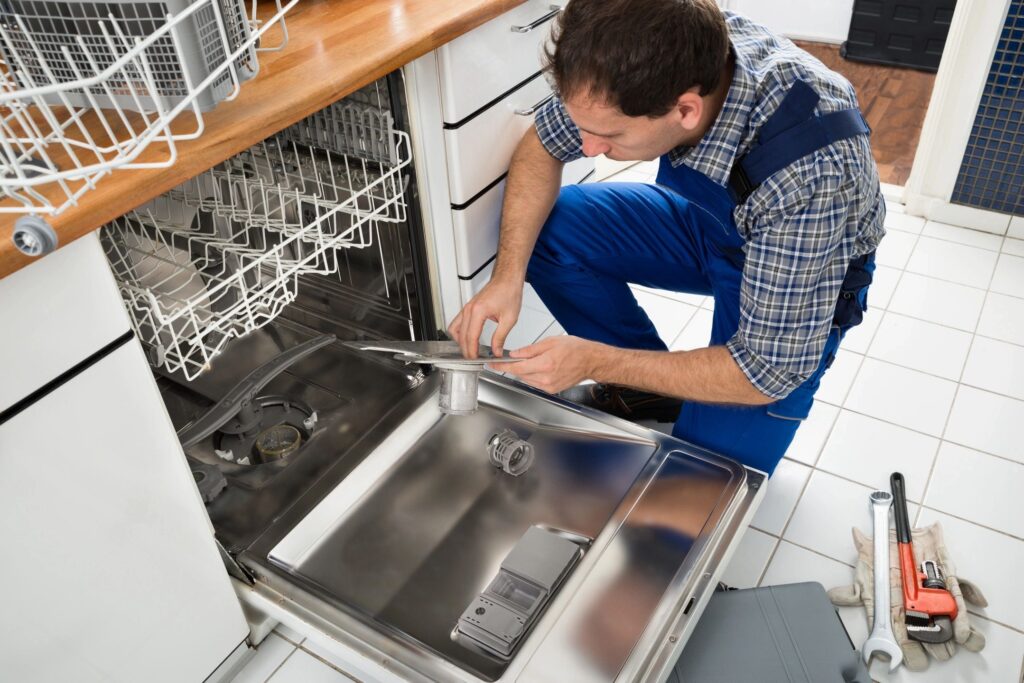Dishwashers are a lifesaver in the kitchen, taking the hassle out of cleaning up after meals. Yet, like any household device, they can run into problems over time. The good news? Many of these glitches can be tackled without professional help. In this article, we’ll explore eight typical dishwasher challenges and provide clear, actionable steps to get your appliance back on track.
1. Dishes Stay Dirty After a Wash Cycle
It’s disappointing when your dishwasher finishes a cycle, but your plates and cutlery still have grime on them. This issue often stems from a few manageable causes.
- Blocked Spray Nozzles: Tiny bits of food can clog the nozzles on the spray arms, stopping water from reaching all areas. Take the arms off, rinse them thoroughly, and use a small tool like a toothpick to clear the holes.
- Filtration Blockage: A debris-filled filter can hinder cleaning performance. Locate the filter, remove it, and wash it under warm water to clear out any buildup.
- Overcrowded Racks: Packing too many items into the dishwasher can obstruct water flow. Arrange dishes with enough space between them to allow water to circulate freely.
- Soap Mismatch: Using the wrong cleaning agent or an excessive amount can leave a film on dishes. Always opt for a dishwasher-safe soap and stick to the suggested quantity.
2. Water Pools at the Bottom of the Dishwasher
If your dishwasher leaves a puddle of water inside after a cycle, drainage issues are likely to blame. Here’s how to address it:
- Obstructed Drain Tube: Debris can block the tube that drains water from the appliance. Disconnect the tube and use a flexible tool or running water to flush out any clogs.
- Air Vent Blockage: Some dishwashers have an air vent that can get jammed with particles. If present, remove the vent cover and clean it out thoroughly.
- Malfunctioning Pump: If the tube and vent are clear but the issue persists, the pump responsible for draining might be broken. This typically requires a technician’s expertise to fix.
3. Water Leaks Out During Operation
A dishwasher that leaks can create a mess and potentially harm your kitchen flooring if not fixed promptly. Let’s identify the source:
- Damaged Door Gasket: The rubber lining around the door can wear out over time, letting water seep through. Check the gasket for cracks or wear, and replace it if needed.
- Loose Pipe Fittings: Inspect the pipes connected to the dishwasher for any loose fittings. Tighten them to stop minor leaks.
- Clogged Drainage Path: A blocked drain tube or filter can cause water to overflow. Ensure both are free of debris to prevent backups.
- Overloaded Interior: Placing too many items inside can lead to water splashing out. Avoid overfilling, and make sure large items don’t interfere with the spray nozzles.
4. Dishwasher Produces Excessive Noise
While dishwashers aren’t whisper-quiet, they shouldn’t sound like a construction site. Loud or strange noises often signal an issue.
- Foreign Objects: Small items like a stray spoon or a loose screw can get stuck in moving parts. Open the dishwasher and remove any objects lodged at the bottom.
- Worn Internal Components: A grinding or whining noise might indicate issues with the motor or bearings. These typically require replacement by a professional.
- Unstable Installation: If the dishwasher isn’t securely fastened to its surroundings, it might vibrate noisily. Check that it’s firmly attached to the countertop or cabinet.
5. Dishwasher Refuses to Power On
When your dishwasher won’t even start, the problem can often be resolved with a few checks.
- Electrical Supply Issues: Ensure the appliance is plugged in properly and check your home’s electrical panel to see if a circuit has been tripped. Reset it if necessary.
- Door Lock Failure: Most dishwashers won’t operate if the door isn’t fully closed. Verify that the door lock engages properly and isn’t blocked by debris.
- Control Board Glitch: An unresponsive control board might be the issue. Try rebooting the dishwasher by cutting power at the electrical panel for a few minutes, then restoring it.
- Safety Lock Activation: Some models have a safety lock that disables the controls. Check your manual to see if this feature is on and deactivate it.
6. Unpleasant Odors Emanate from the Dishwasher
A smelly dishwasher can make your kitchen less inviting, often due to trapped residues or moisture buildup.
- Dirty Filter Residue: Leftover food in the filter can create a stench. Regularly remove and rinse the filter to keep odors at bay.
- Stagnant Moisture: Water that doesn’t drain completely can become a breeding ground for smells. Make sure the drainage system is working correctly.
- Fungal Growth: Lingering dampness can lead to mold inside the dishwasher. Run an empty cycle with a cup of white vinegar or a specialized cleaner to freshen it up.
- Gasket Contamination: The door’s rubber gasket can harbor mold. Wipe it down regularly with a mild cleaner or vinegar solution.
7. Dishes Don’t Dry Properly After Washing
If your dishes come out wet, forcing you to dry them by hand, your dishwasher isn’t doing its full job. Here’s what might be wrong:
- Broken Heating Component: Many dishwashers rely on a heating element to dry dishes. If it’s not working, a technician may need to replace it.
- Lack of Drying Agent: Using a drying agent can improve evaporation and reduce water spots. If you’re not using one, add it to your routine.
- Premature Door Opening: Opening the door right after the cycle ends can release steam needed for drying. Wait a few minutes before opening to let the steam work its magic.
8. Detergent Doesn’t Release During the Cycle
When the dishwasher fails to dispense its cleaning agent, your dishes won’t get properly cleaned, which defeats the appliance’s purpose.
- Jammed Dispenser: Residue can build up in the detergent compartment, preventing it from opening. Clean the compartment with warm water and a small brush.
- Faulty Dispenser Mechanism: A broken latch or spring in the dispenser might stop it from releasing. This part may need to be replaced.
- Cycle Selection Error: Ensure the cycle you’ve chosen aligns with the amount of detergent used. Too much or too little can affect the dispenser’s performance.
Final Thoughts
Keeping your dishwasher in good working order through regular upkeep and quick troubleshooting can save you time, effort, and expense. By identifying the causes of issues like poor cleaning, water leaks, or odd sounds, you can often resolve them on your own without expert intervention. For more complicated problems, though, don’t hesitate to seek professional assistance. With consistent care, your dishwasher will remain a reliable kitchen companion, ensuring your daily cleanup stays effortless for years to come.

